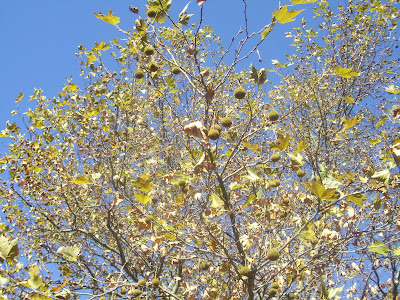Again, I've been busy, but who isn't? I hope everyone had a great winter break. My New Year's resolution is to put out more of these tree entries with fewer long gaps of time in between. I think all of us can benefit from that! :) Anyhow, onward with our next tree! The white oak is one of the most common native species in Virginia.
Common name: White oak
Scientific name: Quercus alba
Family: Fagaceae
 |
| Here's a white oak! We're in my yard today. |
 |
| A closer look. Oh, by the way, members of the family Fagaceae (oaks, beeches) like to keep their leaves during the winter. Not sure why. |
 |
| But I guess if I were a tree and I had a choice, I'd keep 'em. |
 |
| Here's some bark! |
 |
| Here's a leaf. This one has 7 lobes and its sinuses almost extend to the midrib. |
 |
| Twig with leaves. |
 |
| Here are some white oak terminal buds. Not a good picture, but I hope you see what I mean by rounded and clustered. |
Form and Size: The white oak can reach 60-100 feet in height and 2-4 feet in diameter. It is a tall tree with a rounded crown and spreading branches.
Habitat: White oaks live in dry to moist woods.
Leaves: The leaves are alternate and simple, with 7-11 rounded lobes. Leaves are hairless and 3-9 inches long. Sinuses between lobes vary from shallow to almost reaching the midrib of the leaf.
Flowers: Male catkins and female flowers appear with new leaves in spring.
Fruit: The fruit is an acorn with a warty, bowl-shaped cap that covers about a third of the fruit. Acorn is 3/4 of an inch long.
Twig: The twigs are red-brown with small, clustered and rounded terminal buds.
Bark: The bark is grey with a few possible patterns, from smooth (on older trees) to scaly or blocky.
White oak has wood that is used in lumber and furniture. Wildlife also love to eat its acorns (squirrels, deer, bear, to name a few species).
The top things I would use to remember the white oak are its buds, leaves, acorns and bark.
New Vocabulary:
crown: the upper part of a tree.
midrib: the center vein of a leaf.
The Earlysville Oak:

Here is a special addition to our white oak entry! The Earlysville Oak, as described in Remarkable Trees of Virginia, is a white oak that survived construction on the nearby Charlottesville-Albemarle airport, and is old enough that it "may have witnessed General Custer passing through this area" (148). I drive by this tree a lot, and I love looking at it. I hope you all can meet the E'ville Oak (if you haven't already) in person and read up on its story. The Daily Progress has a news article on it, and it has its own place in Remarkable Trees of Virginia. The book was a collaborative effort between Nancy Ross Hugo, an outdoor writer, Jeff Kirwan, a forestry professor at Virginia Tech, and Robert Llewellyn, a photographer. Check out the book! It's great!
To get to the E'ville Oak, go through the traffic circle by the Charlottesville-Albemarle airport. You should see it by a small church.
P.S. According to page 12 of Remarkable Trees, the oldest age a white oak can reach is about 600 years. Is that cool or what?
Sources used:
1. Common Native Trees of Virginia by the Virginia Department of Forestry, 2010 Edition (Book)
2. Eastern Trees by George A. Petrides and Janet Wehr, Peterson Field Guide Series, 1998 (Book)
3. VT Dendrology-White Oak Factsheet
4. Remarkable Trees of Virginia by Nancy Ross Hugo and Jeff Kirwan












